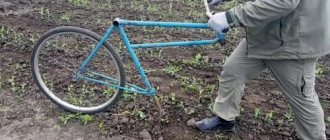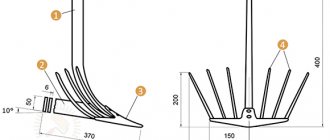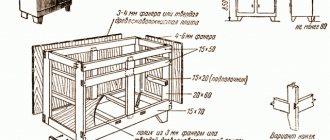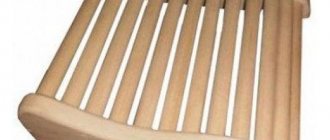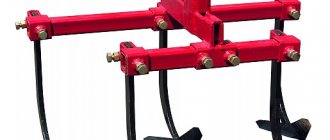A plow is a labor tool designed for plowing hard soil and has been used by man since ancient times. The intended use of a plow determines its technical and quality characteristics: the design of the frame and cutting element, fastening mechanisms and stops, material of manufacture and its thickness.
General characteristics
There are several types of plows according to their purpose:
- manual - for plowing soft land of a small area;
- horse-mounted - used in situations where it is necessary to cultivate land, access to which is limited for special equipment;
- with rope traction - helps to cultivate the soil in hard-to-reach places, for example, in the mountains or in a swamp;
- mounted – works in conjunction with special equipment, allows you to reduce the turning radius during sequential plowing;
- trailed – general purpose plow.
The mentioned types of plows, in turn, are divided into the following subspecies:
- single-hull;
- double-hull or more;
- disk - reversible;
- rotary.
The generally accepted configuration of a plowing tool, which you can construct with your own hands, is shown in Figure 1.
The main parts of the hull structure have the following parts:
- chisel – pad on the cutting part;
- ploughshare – removable “knife”;
- wing, chest and blade feather;
- uglosnim – cuts corners from layers of soil;
- stand – fastening element.
Modern technologies make it possible to make a plow with your own hands. You can design it according to your drawings or modify a ready-made one to suit your needs. A tool made independently has a number of advantages and characteristic design features.
Homemade plow: existing types, their pros and cons, manufacturing technology
Cultivation of land is the most labor-intensive task for rural residents and summer residents. Preparing the soil for sowing and cultivating the land after harvesting are the most difficult types of manual work. A plow can greatly facilitate the performance of these works.
A plow is an agricultural tool with a wide metal blade that is used to plow the ground. In addition to tillage, plows are used for underwater work, for laying cables, and when searching for oil.
At the first stages of using the plow as an agricultural tool, people dragged it behind them , a little later they began to use livestock (oxen, horses) for this, today this hard physical work has been transferred to agricultural machinery - the tractor.
The main task of this tool is to turn over the top layer of soil. This procedure (ploughing) largely frees the soil from weeds. During the plowing process, the root system of weeds that have already begun to grow, but are not yet strong enough, is damaged.
In addition, along with the overturned layer of earth, the seeds of weeds that have not yet germinated are moved deep into the soil, which, of course, complicates their further germination. Many weed seeds are completely destroyed during the plowing process.
During the plowing process the soil loosens , becomes softer and more pliable, which subsequently makes sowing more effective and has a good effect on the germination of cultivated plants.
Modern agriculture uses different types of plows to cultivate the soil. These agricultural implements differ according to two characteristics:
- by aggregation method;
- according to the method of plowing.
According to the method of aggregation, plows are trailed, mounted and semi-mounted. Each type has its own advantages and disadvantages.
The trailed plow can only be driven using transport wheels. It is rarely used in modern agriculture, because the majority of tractors are equipped with a mounted system with a built-in hydraulic cylinder.
The advantages include the fact that, according to agronomists, after cultivating the soil with a trailed plow, the arable land is smoother and more uniform.
The disadvantage of such a tool is the rather large rotation angle, which prevents the use of this plow along with mounted and semi-mounted ones in the same paddock.
Features of a homemade model
A plow assembled with your own hands is a tool that meets target needs and has a low cost. To assemble it, you can use materials available, as well as parts of the structures of other agricultural units. The latter can be taken from old agricultural workshops, ferrous metal collection points, and other similar places.
A homemade plow can be easily adjusted to suit your needs. It is possible to adapt it to different types of soil, draft mechanisms, and even to the functions of processing agricultural crops. Your own plow can be manufactured taking into account the power and productivity of tractor equipment, which will allow you to achieve the highest efficiency and reduce destructive loads on the plowing tool.
The cutting element of this plow can be replaceable and manufactured/sharpened independently, which significantly reduces the cost of servicing the mechanism. With independent production, it becomes possible to vary the intended use - introducing the function of replaceable elements: nozzles, fasteners, parts of the body and frame. This allows for combined work, such as plowing and mowing bushes.
When making your plow, you can pay special attention to the choice of materials and their quality. This is one of the key advantages of homemade assembly, since when buying a plow in a store, it is difficult to be sure of the quality of the metal used to manufacture the factory unit. After purchasing a store model, you may need to further refine it or replace some low-quality structural components.
Video tutorials on making plows
This problem probably occurs for many gardeners and vegetable gardeners. There is a small plot of land - one or three acres, and it needs to be plowed. It’s a chore to shovel, the horse is nowhere to be found now, the tractor won’t get in. Buying a cultivator for a buck and using it for an hour a year is a toad's crush. I started digging around the Internet - is it really a hand plow, just our invention - and what did the greedy bourgeoisie come up with?
It turns out that the bourgeoisie had such a device for a long time, but they used it only for subsequent improvements to the land - surface cultivation, shallow hilling, making furrows during planting. That is, to manually pull a plow over the turf instead of a horse by two people, this is not observed there. It’s probably better for several owners to come together in the area and buy a walk-behind tractor. This is how collective farms and socialism appear, which is also not encouraging. And this is how they plowed; women in a Dutch field 1919 Use hand plows to make furrows for planting poppies:
At the beginning of the 20th century, hand plows with large wheels were made almost en masse:
The bourgeoisie used the same principle to make hand cultivators.
Now let's look at our handicrafts. Due to the increasing need for hand plows, they began to be produced at almost every factory. The designs of such a product are almost identical for all and are intended for use as a burden for an over-aged child, who will do physical exercise on one hundred square meters and help his parents. It looks like this:
These designs are constantly being improved by both enterprises and craftsmen. Rollers and discs are installed, and either a rope or a pipe with a cross member is used as traction. A bicycle frame can be used:
A very interesting Belarusian homemade product, I liked the shape of the hand plow – hiller:
In parallel with such searches, I found an antique American manual lawn mower. Everything is primitive - a pair of knives, two wheels. And also the hand harrow of the old cowboys. Maybe someone will try:
Here it is, a drawing of a hand plow:
See also:
Repairing an electric trimmer I will write another article in the do-it-yourself repair series. This time we are repairing a lawn mower trimmer. The start button on this important summer power tool has broken down; it was probably mowed down by a hare.
How to clear snow There is snow all around. It is vital to ensure access to your home. You need to find the strength within yourself and replace your computer with a snow shovel. It’s even better to organize the younger generation for such work and provide for it yourself.
How to choose a trimmer I will not get into an argument about which is better, a trimmer or a lawn mower. They are tools designed for different purposes. And if you have more than three acres of lawn with trees, then it’s better.
Materials and tools
Making a homemade plow for a mini-tractor requires the following basic tools:
And an additional tool, the list of which is determined by the design of a particular mechanism and the conditions of its production.
The materials making up the main structure must be solid steel blanks. Violations of their integrity - cracks, deformation, severe rust - are unacceptable.
List of materials that may be needed:
- thick-profile sheet metal of high strength;
- metal corners and plates of sufficient thickness;
- bolts of various calibers;
- additional items (washers, bearings, springs) determined by the characteristics of a particular design.
How to do it?
In order to facilitate the process of assembling a plow for a mini-tractor, you can go by reconstructing another tool of the same name, used in conjunction with draft objects: a horse-drawn plow or a skimmer from the plowing mechanism of a large tractor.
Assembling the required unit requires drawing up the correct drawings. Their presence will ensure optimization of the design, reduction in the number of components, simplicity and quality of assembly.
The drawings should indicate the dimensions of the elements, which are closely related to the dimensions of the mini-tractor and the properties of the cultivated soil. During the manufacturing process, it is important to adhere to these parameters.
At the design stage, it is worth drawing separately each detail that has an irregular shape, respecting its natural size. In the future, from such drawings it will be possible to create a pattern for transferring the image of the part onto a metal workpiece. Some variations of the plow drawing are shown in Figures 2 and 3.
Let's consider two options for making a plow for a mini-tractor.
From a horse plow
This plow configuration, mounted with a mini-tractor, is considered the easiest to manufacture. All work on reconstructing a horse-drawn plow comes down to adapting to it a frame that has a special fastening mechanism, equipping it with a wheel (if necessary) and a weighting agent.
A horse-drawn plow consists of a body and a double-sided frame, which serves as a mechanism for attaching to the animal's harness and as a means of controlling the plowing process. Its simplest configuration is shown in photo 4.
In this case, it is necessary to reconstruct the mounting part of the horse-drawn plow into one that will be installed on a mini-tractor with the least effort. This process can be simplified by making a tow bar for a tractor mount. A copy of it is shown in photograph 5.
The towing device is easy to manufacture. A wide plate, which has two horizontal holes with internal threads at the edges, is complemented by a protrusion in the middle, into which a fork ball with a leg is screwed/welded. An L-shaped part is attached to the center of the plate, serving as a locking mechanism for the plow frame mounted on the tow bar. The plate is placed between the two “ears” of the tractor mount and secured with four bolts.
The modification of the horse-drawn plow shown in photograph 4 is equipped with a special wheel. It serves as a support for the structure frame; it can be used to adjust the depth of penetration of the plow into the soil.
Adjustment is carried out using a simple mechanism - a threaded bracket into which a clamping bolt is screwed. The wheel stand can move vertically inside the bracket. The bolt fixes it in the desired position. This design allows, if necessary, to move the bracket along the plow frame.
Read also: At what temperature to weld polypropylene pipes
The wheel itself is made of a metal rim, spokes and an axle drum. To make it, you can use a 300x50 mm metal strip, reinforcing bars, or a piece of pipe with a diameter equal to the diameter of the wheel axle.
The metal strip is bent in the form of a hoop, its edges are welded together, the weld seam is ground with a grinder or cutting wheel of an angle grinder. A piece of pipe equal to the width of the tape is placed in the center of the circle. The distance from the rim to the outer surface of the pipe - drum is measured. The reinforcement spokes will be equal to this distance. The resulting blanks are welded together. To improve the torsion characteristics of the wheel, a bearing of the appropriate diameter can be welded into the drum. This will reduce friction and reduce the load on the wheel axle.
The described plow design can be operated in two ways. In the first case, a second person will be needed to control the plow from behind, adjusting the furrow line. In this case, the “manager” applies pressure on the frame necessary for sufficient immersion of the ploughshare into the ground.
In the second case, the presence of an assistant is not necessary. The plow becomes heavier and moves on its own. The load can be a piece of heavy metal or a stone enclosed in a frame. The weighting agent is placed on the edge away from the tractor. In this case, the pressure on the share will be maximum with the available weight. To prevent the load from overturning the plow, it should be secured on the underside of the frame.
When operating a plow without a second person, it is worth considering the factor of furrow curvature. The simplicity of the described design assumes that the plow “swims” from side to side. To eliminate this problem, it is necessary to equip it with a “hard” clutch with the tractor. In this case, the draft mechanism will straighten the furrow strip.
From skimmers
A skimmer is an element of a tractor plow that serves to cut off the top layer of soil during plowing. Photo 6.
Its shape is similar to the working body of a plow share, and its size is half the size. This fact allows you to effectively use the skimmer as a plow for a mini-tractor.
During the design process, you will need to weld a frame that will hold the skimmer and attach it to the tractor towbar, and also equip it with a stop wheel.
When creating drawings of this design, it is worth taking into account the power of the tractor, the condition of the cultivated soil, and the volume of future work. If you plan to plow a large area of land, you can use two skimmers on one frame. In this case, the plow will have a double body. This is necessary in order to reduce the load on one plowshare body and reduce its wear.
The process of assembling the structure and installing it on a tractor is similar to reconstructing a horse-drawn plow. A frame of a similar configuration, a wheel, fastenings for the ploughshare stand and the entire structure to the towbar are made. A weighting device or control handles are installed for manual correction of the furrow.
Plow device
It is possible to make a plow correctly only when you have an idea of the plowing process, as well as the purpose of each of the plow parts.
When plowing, the plow wedge cuts into the ground at a certain angle, depending on the softness and moisture of the soil. The wedge separates the layer, lifts and compresses it, while simultaneously dividing the layer into several parts. The angle of entry determines how many parts the earth layer will be split into: the larger the angle, the larger the split. But if the angle of entry is more than forty-five degrees, then the soil stops sliding along the working surface of the arable device and begins to accumulate in front of it, making further work difficult. A vertical plow, that is, with a sharper leading angle, separates the soil from the edge of the plow furrow and compresses it horizontally. A plow with a horizontal leading angle works differently: it deflects and turns over the soil layer.
A typical working plow consists of:
- The ploughshare that cuts the soil,
- dump,
- Knife,
- Field boards,
- Racks,
- Skimmer.
Additionally, the plow can be equipped with:
- More durable metal frame,
- With wheels,
- A mechanism that corrects the operation of the plow relative to the tractor,
- hydraulic mechanisms,
- Pneumatic hydraulic system.
The blade can have several types of working surface:
- Screw,
- Cylindrical,
- Cylindrical.
The cylindrical grinds the soil perfectly, but does not form a layer well. This is not always convenient. A cylindrical work surface is usually used for working with soft soil. The most convenient and practical to use is a cylindrical surface, which crumbles and turns the soil well, and also copes with both dry and wet soil.
Safety precautions
When operating a homemade plow, appropriate safety measures must be observed. Among them, the most important points can be highlighted.
- while the plow is moving along the furrow, it is unacceptable to adjust it in height, clear the wheel and ploughshare from the earth and other manipulations associated with human participation;
- all connection points must be securely fastened - play is unacceptable;
- it is necessary to carry out timely cleaning of mechanisms and sharpening of cutting elements;
- Perform all actions only with the plow immobilized and the tractor turned off.
To ensure labor safety, it is important to carry out work that meets the technical characteristics of a specific agricultural mechanism. Excessive loads can lead to rapid wear, damage to the unit and harm to human health.
To learn how to make a plow on a mini-tractor with your own hands, see the following video.
DIY plow drawings
After I got a self-made agricultural winch, which is used for plowing the garden, the question became: should I buy a plow or make it myself? Walking through the shops and bazaar of Smolensk, you get a strange feeling that the plows produced by the industry for walk-behind tractors are a sad sight.
And these industrial creations are suitable only for “picking” and not for plowing the land, and even with the rotation of the layer, and regarding the depth and width of plowing, we can conclude that for planting potatoes with a distance between rows of 60 cm, not one of the proposed ones is suitable in the plow trade. Either our manufacturers are saving money, or the power of the most popular walk-behind tractors is not enough to work with a normal plow with a working width of 30 cm. When planting potatoes, you shouldn’t plow one furrow three times. And the price wants to leave the best - under 2 thousand. rubles (for a couple of pieces of iron from a scrap metal collection point).
The next step to find something useful is to search the Internet. To my surprise, there are 3-4 original descriptions with drawings floating in the vastness of the Russian-language network (this fact surprises me very much). The next step is to look at what those around you are using. It was not possible to buy a suitable plow; the decision was made to make a plow with our own hands. Based on the fact that the plow was supposed to be used for planting potatoes with a winch for plowing, the following requirements are imposed on it:
1. Plowing width – up to 30 cm.
2. Plowing depth -10-20cm.
3. The plow must hold the furrow itself, without digging in or jumping out of the furrow. The geometry of the plow must ensure movement with the specified parameters without the help of a plowman.
4. Possibility of adjusting the depth and width of plowing.
5. Minimum weight and sufficient strength.
My uncle has been using his homemade motorized winch for plowing for more than 10 years and has tried several options. For the last few years, he has settled on an option optimized for a homemade motorized winch for the garden, namely for planting potatoes with a distance between rows of 60 cm. There is also a homemade hiller for a motorized winch and a homemade potato digger, all this can be viewed on the corresponding pages of the site.
Plow drawing
Field board drawing.
The blade is bent according to this template until the two profiles coincide and then welded at an angle.
Using a drawing of a homemade plow, you need to draw a template for the plow pattern on thick paper, and then transfer the picture to metal and cut out the blank with a grinder. Personally, I used stainless steel material with a thickness of 1.8 mm. Many often use a sheet of 2-3 mm. The cutting part of the plow is reinforced with a strip of thicker metal. Someone suggests using a disk from a circular machine for these purposes, or a spring from a “Muscovite”. From personal experience, if you plow a summer cottage plot for a family of 4 people in the spring and fall, cultivating six acres, you shouldn’t strive for super-strength. It is more profitable to make a plow that is light but strong enough for its tasks. It’s better to repair or replace something after 10 years, and only if necessary, than to carry around the heavy structure of a homemade plow for 10 years. There is no need for excess weight.
Read also: Examples of the location of spotlights on the ceiling photo
This is what the plowing width adjustment system looks like. By rearranging the large wheel, you can change the plowing width within significant limits. When I plant potatoes, I set the grip to 30 cm, in two passes the distance between the rows is 60 cm. For autumn plowing of the garden or when plowing virgin soil, I use a smaller grip. The small wheel is made so wide that the plow does not press into the ground.
Having looked at the pictures below, you can imagine the basic principles of operation of a homemade plow, or rather a guide system that allows the plow, without the participation of a plowman, to move strictly in a straight line at the established plowing depth and width. The plowing width is regulated by moving the large wheel, which, when the point of application of the traction force is shifted as shown in the figure, is pressed against the furrow, which allows the plow to repeat the direction of the previous furrow. The plow turns slightly, which increases the plowing width. In fact, the width of the nose in the direction perpendicular to the axis of movement of the plow is less than 300 mm, however, the specified width is available for plowing.
The plow wheel runs along the bottom of the plowed furrow and this situation is observed from the previous furrow to the next. As a result of the application of traction force, a force is exerted to deepen the plow until the plow is aligned with the axis of the wheel, as shown in the figure, as a result, all forces are balanced, and the system operates very stably. Rough adjustment of the plowing depth is carried out by selecting the appropriate difference in wheel diameters, and smooth adjustment is carried out by adjusting the tilt of the plow. At this stage, there was no longer any need to use handles to control the plow, except for some special plowing conditions.
Plows not only loose soil as in the video, but also virgin soil
Structure and types of plows
To make a plow with your own hands, you need to have information about its structure and the purpose of its parts. General purpose arable implements are most often used. It consists of several parts, which can be divided into working and auxiliary:
- workers:
- body - consists of a stand to which a ploughshare with a blade and a field board are attached;
- knife - the main cutting part;
- skimmer - an additional cutting part that cuts the turf layer of soil;
General purpose plow design
How does this plow work? The skimmer removes the top layer of soil with plants growing on it, turns it over and places it at the bottom of the furrow, which is the result of the work of the body. The body with the equipment cuts off part of the soil from the side of the furrow, loosens it, turns it around a certain angle (depending on the design), and lays it on top of an inverted layer of turf (laid with a skimmer). To level the furrow wall, a knife is placed in front of the last plow body.
General purpose plows can provide a plowing depth of 20 cm to 30 cm, plowshares - from 16 cm (they also do not have a knife and skimmer).
Housings
According to the number of bodies, plows are single-body, double-body and multi-body. The body consists of several parts:
- rack;
- working surface - ploughshare and blade;
- field board.
Body with share and blade
The ploughshare and blade are the working surface - this part is responsible for the quality and type of plowing. The soil layer is cut with a ploughshare, along which it rises to the dump. Here the soil crumbles and turns over. The degree of formation rotation depends on the shape of the dump. A field board is attached to the bottom of the body. Its task is to prevent the plow from moving towards the already plowed area.
If you are going to make your own plow, you need to choose a design based on the type of soil you are going to cultivate. Plow bodies are:
- Dump. For plowing with full or partial rotation of the formation. Such plows promote soil formation (grown plants are cut and placed at the bottom of the furrow, where they rot), and enrich the soil with oxygen (due to loosening).
- cultural - used for long-cultivated lands, crumbles the soil well, wraps to a medium degree;
- semi-screw moldboard bodies are used for cultivating virgin soil, plowing heavily turfed soil, it wraps the soil well, crumbles it moderately (models with an elongated feather wrap the layer completely);
- screw - good for cultivating virgin soil - the layer is completely wrapped;
Plow for agricultural winch – video
The plow is used in conjunction with such a winch for plowing
You can find industrial motorized and electric winches for plows on sale.
A walk-behind tractor is a worthy replacement for mini tractors in small farms and household plots. Equipped with a diesel or gasoline engine, depending on the power, in one work shift it is capable of processing an impressive area, plowing it manually would take many times longer.
Homemade assembly of a power unit (motoblock) is impractical due to the high cost and complexity of the process. But its main working body - the plow - is a simple matter to make and assemble with your own hands, as we will see in this article.
Plow on a walk-behind tractor: varieties and their design features
A plow is a special device for plowing the soil, equipped with a metal share.
Designed for loosening and turning over the top layers of soil, which is an important part of pre-sowing and fall treatment. Initially, plows were pulled by people, and somewhat later by farm animals. Today, a plow on a walk-behind tractor is one of the options for using this mounted auxiliary equipment, in addition to a tractor or mini tractor. Depending on the shape of the main working elements, plows on walk-behind tractors are:
- plowshares;
- dumpless;
- disk;
- rotary;
- combined.
By type of ploughshare:
- screw;
- cylindrical;
- semi-cylindrical.
Based on the number of working parts:
- single-body plow on a walk-behind tractor;
- double-hull;
- multi-hull models designed for extremely complex tasks.
In addition, plows for walk-behind tractors, according to the specifics of fastening, are divided into conventional and reversible.
Reversible plow model
First of all, they are distinguished directly by the shape of the ploughshare, which in appearance resembles a bird feather. Due to the fact that its upper part is bent, the soil has the ability to turn over. Suitable for processing difficult soils.
This type of plow got its name from the peculiar way it tilled the soil. It's like he's wrapping her around. This technique is convenient for long lengths.
How to make a plow on a walk-behind tractor with your own hands?
A plow on a walk-behind tractor with your own hands is not a transcendental thing, but quite real. Thanks to proven drawings and high-quality materials, this process is reduced to several successive stages, ultimately resulting in a unit with low cost and high production resource.
The plow for the walk-behind tractor shown in the drawing is considered universal.
In order to make a homemade plow for a walk-behind tractor, you need to remember the following nuances:
- deviation from the standard dimensions of a proven design may result in breakdown of the unit;
- for a plow it is worth considering a mounting stand that would allow it to be adjusted and installed on the walk-behind tractor itself. It is best to choose all-metal plates 1 cm thick for these purposes. By adjusting the stand, you can set the desired plowing depth;
- the blade must withstand heavy loads. For this, the most suitable material would be sheet steel of standard thickness. The main thing is not to overdo it with the bend. It is advisable to use a gas heater to heat the pipe and bend it in the direction required according to the drawing or workpiece;
- ploughshare - a composite plow mechanism that directly interacts with the ground, preferably made of high-alloy steel or a special grade of steel “Sormite”. The difference in the thickness of the top and bottom layers will ensure uneven grinding and long-term work without sharpening.
Let's consider some options for a homemade plow on a walk-behind tractor.
Plow assembly
When starting assembly, it is recommended to first make a layout using thick cardboard, gluing individual parts at certain angles. In the presented drawings, the alpha angle in various areas is 25-30°, the gamma angle is 42-50°. Having assessed the resulting cardboard sample, we begin manufacturing it from metal. The material for the housing is made of sheet steel with a thickness of 3.0 mm.
To complete the assembly, we will use a welding machine. You will need a steel sheet 2-3 mm thick with dimensions of 0.5x0.5 m. Using wedges installed at an angle of 25°, place a ploughshare on the sheet and weld it to the sheet in two places. We vertically join the side shield to the plowshare, overlapping it by 5-8 mm. The shield must be positioned 0.6-1.0 cm above the ploughshare blade (leaf plane) in order to freely cut the soil. We attach the shield with tacks to the ploughshare and the auxiliary sheet. We attach the blade to the plowshare so that we get a solid structure. The angle between the plowshare blade and the edge of the blade must be set to 6-8°.
Share attachment
The plow mounting diagram is shown in the drawing.
If any of the corners or surfaces do not coincide or do not meet the recommended ones, the part will need to be corrected with a hammer. Having adjusted the blade and the ploughshare, we weld them, after which we fasten the blade with tacks to the side shield. We first weld the side shield with the spacer bar, then with the plate located at the base, now we weld the thrust corner of the ploughshare to it. We inspect the entire unit, and now we need to carefully weld the seams, then separate them from the auxiliary sheet. After completing the assembly, the seams must be thoroughly cleaned with a grinder, and the surfaces that will be in contact with the ground must be sanded.
Reversible plow for walk-behind tractor: do it at home
The reversible (reversible) plow to the walk-behind tractor is externally distinguished by its curved shape, which helps turn the top layer of soil by 1800. It has gained enormous popularity on hard soils, where conventional loosening does not bring the expected result. Its device is the most complex among other varieties.
A universal version of a reversible (reversible) plow is shown in the figure.
The size of the structural elements is detailed in the drawing. To invent it you will need to do (notations according to the drawing):
- plowshares (a) made of steel. It is desirable that they be removable for possible sharpening or modernization. The cutting part is processed on an anvil and sharpened. The lower one is designed for cutting into the soil, the upper one turns over the cut layer. The strength of the latter can be strengthened with a corner welded to it;
- form a dump, there are several ways to do this. According to one of them, a steel pipe with a diameter of no more than 6 cm is taken, to which a cardboard blank is attached. There should be about 20 0 between the generatrix of the pipe and the stencil;
- side part of the stand (b);
- spacer plate (c);
- base of the product (d);
- corner (d);
- stand (e).
The diagram shows the assembly sequence of the rotary plow, where 1 is the share, 2 is the side part of the stand and 3 is the auxiliary sheet. A variation of the standard reversible plow is the Zykov rotary plow, the distinctive feature of which is the reinforcement of the plowshares with steel blanks on bolted ties and a large angle of attack. An additional wheel can be used to ensure structural stability.
In the proposed drawing it is highlighted in yellow.
Homemade single-furrow plow
The simplest, but at the same time effective plow design is a single-body plow.
This design is suitable for making it yourself at home. Manufacturing will not require special tools and devices, as well as special skills; the tools available in the home craftsmen’s workshop will suffice.
ploughshare
The experience of owners who use walk-behind tractors equipped with plows in their field work shows that the ploughshare must be periodically removed in order to sharpen it before starting work. When choosing materials for the manufacture of a plowshare, we recommend using alloy steel 9ХС, which is used in the manufacture of circular saws.
45 steel can be used, but will need to be hardened to HRC 50-55. It is possible to use ordinary steels, including St.5, which are not subject to hardening, but can be brought to the required quality if the edge is beaten with a hammer and sharpened.
Blade
A plow moldboard can be made using different methods; let’s look at some of them so that we can choose the most convenient and affordable one in terms of materials and cost.
- The blade is made of steel sheet with a thickness of 3.0–4.0 mm. For manufacturing, bending rollers are required to give the blade a curved shape. The workpiece is cut out according to a template, then passed through rollers and hammered to the required shape.
- You can make a dump using a steel pipe with a diameter of 0.55-0.6 m and a wall thickness of 4.0-5.0 mm. We prepare a cardboard template in advance and place it on the pipe so that the angle formed by the bottom edge and the horizontal of the pipe is 20-30°. The outline is outlined, cut out using a gas torch, and then processed with sandpaper or a grinder. If necessary, you can correct the shape with a hammer.
- When making a blade, you can use a steel sheet, but the shape can be given after preheating the workpiece by bending it along a matrix, for example, by taking the blade of a purchased plow.
You may need information about a potato hiller for a walk-behind tractor or a homemade potato digger.
Rotary plow on a walk-behind tractor: advantages of the unit
It has the most advanced form for plowing virgin soil and areas overgrown with weeds to a depth of about 30 cm. A homemade rotary plow includes:
The walk-behind tractor on which such a tool is mounted must have a working power take-off shaft. It is he who drives the axle, and she – the plowshares.
Read also: Charging 18 volt caliber
Homemade rotary plows for walk-behind tractors are most often found with disk mechanisms. But drum, blade and auger plows are also known. Indispensable for applying fertilizers and controlling weeds.
Single body plow model
Such models have the simplest design. Looking at a photo of a homemade plow, which belongs to the single-hull category, you can see that it only includes a ploughshare.
Suitable only for soils that are light. It is impossible to use it for working in virgin lands or, for example, in difficult soil.
There is also a type of plow consisting of two bodies. They look like two frames that are fastened together, and this design is also topped with plowshares.
This type not only plows, but also harrows the soil. At the same time, the quality of soil cultivation increases significantly.
DIY disc plow
A disk plow on a walk-behind tractor or a hiller plow is a special device used for cultivating the soil before planting tuber crops. Lays furrows for planting potatoes, beets, celery, and hills them.
Below is a diagram and drawing of the hiller
Its structure includes:
- 2 – disks;
- 3 – fist;
- 4 – bracket;
- 5 – axis;
- 6 – scraper;
- 7 – driving beam;
- 8 – screed;
- 9 – handle.
The number 1 indicates the work area.
Discs can be taken from an old seeder. Their installation is carried out at an angle to improve the productivity of arable work. Attaching the hiller to the walk-behind tractor through the hitch bracket. The T-shaped plow leader is screwed to it with bolts and a stopper. At high speed, the hiller may begin to slip. Therefore, you need to work with it only at low speeds or with paired wheels.
According to another instruction, the disk plow for the walk-behind tractor begins to be assembled by cutting out an equilateral corner. The toe is welded to it, and then through the thrust bar and the heel. The discs are mounted on special hinges, which are welded to ensure their symmetrical position to the common axis.
Do-it-yourself plow to a walk-behind tractor from a horse-drawn tiller
An equally viable idea is to recycle an old horse-drawn plow into a walk-behind tractor. A full description of the process is given in the video.
A feature of all horse plows without exception is their heaviness, created by a bulky moldboard. If such a plow is installed on a walk-behind tractor without modification, the ground will not tilt.
This is a big plus, since the horse plow share will not undergo any changes.
To make a plow from a horse horse into a walk-behind tractor you will need:
- make your own blade, which is cut according to a pre-drawn drawing from a steel blank (3 cm thick). For accuracy, it is advisable to make a cardboard template;
- after cutting, the stainless steel blade is given a special shape;
- remove the horse blade and install a homemade one instead;
- remove the handles that were on the vertical axis;
- Instead, weld metal fasteners through which the plow will be hung to the walk-behind tractor.
- If during field testing it turns out that the converted horse plow does not throw well, the ploughshare should be slightly bent so that it can cut deeper into the soil.
Installing a plow on a walk-behind tractor: step-by-step steps
Before you attach the plow to the walk-behind tractor and start setting it up, the draft unit itself must go through a number of preparatory procedures. They boil down to:
- transporting the walk-behind tractor to where it will be used;
- dismantling the wheel travel, which is replaced by lugs. Otherwise, the equipment will begin to slip and may get stuck.
Once these requirements have been met, installation of the plow can begin.
It means:
- fastening the plow to the hitch of a walk-behind tractor with nuts, which will allow you to independently set its operating parameters in the future;
- prepare two fastening pins with which to attach the hitches and plow to the shackle.
This completes the task of installing the plow and you can move on to the next one.
How to adjust a plow on a walk-behind tractor?
Adjustment is an extremely important point on which the performance of not only a homemade or factory plow, but also a walk-behind tractor depends.
To correctly set up a plow on a walk-behind tractor, you need to pay attention to three key parameters:
Work progress:
- set the width along the edges, for which the edge should not move above or below the soil hook;
- Place the walk-behind tractor stably on stands to set the depth required for plowing. It must be remembered that it varies by season (in winter up to 0.25 m, and in spring about 0.2 m);
- adjust the attachment of the plow to the walk-behind tractor;
- make bolt fastenings so that the rear of the plow is in the same plane with the soil;
- remove the walk-behind tractor from the stand.
The setting is considered complete if the steering wheel is located at the level of the operator’s waist.
Plow on a walk-behind tractor: review of popular models and their characteristics
Although industrial modifications are inferior to home-made analogues in terms of costs, they are highly reliable and durable. There are many different models on the modern market, which differ not only in requirements for soil quality, but also in the technical parameters of the power plant itself.
Plows for the Salyut walk-behind tractor
"Salut" is a well-known brand of cultivators and walk-behind tractors. Thanks to the plow, the soil is plowed to a depth of up to 25 cm. They function with the following types of plows:
- reversible, suitable for dense soil - the heaviest of those considered;
- single-hull without coupling, the weight of which is 9.55 kg with a plowing depth of up to 200 mm;
- a Zykov rotary plow weighing 9 kg, which loosens 20-25 cm of the top layer of soil.
Plows on the Mole walk-behind tractor
The Krot motor cultivator is known in several modifications - MK-1 and Mk-2. Both are perfectly compatible with universal reversible plows. For better adhesion to the surface, it is necessary to purchase additional lugs.
Technical characteristics of the "Mole" plow:
- Processing width – 20 cm;
- Plowing depth – 20 cm;
- Weight – 8 kg.
Plows for the Neva walk-behind tractor
The Neva walk-behind tractor has several basic modifications, including MB-1 and MB-2. They differ in power and transmission. Therefore, they are equipped with different adapters.
MB-1 is compatible with a universal single-body plow without a hitch, as well as the P1 20/3 model. The latter covers a row 22 cm wide and is adapted to over-compacted soils.
MB-2 works with:
- plow “Mole” (1-furrow), weighing 8.5 kg;
- 2-turn with 15 kg weight and 20 cm processing;
- single-furrow plow P1-20/2 (8.5 kg).
Plow for MTZ walk-behind tractors
The following plows can work with the MTZ-09N motor cultivator and other modifications of the manufacturer:
- universal reversible PU-00.000-01, made of steel and having a specific ridge shape;
- P1-20/3, smaller in size than the previous one;
- reversible double-sided with feather-shaped ploughshare. Together with such a plow, the walk-behind tractor can be operated at a speed of 2-5 km/h.
The universal plow of the PU series has gained great popularity. Its features are:
- light weight;
- ease of transportation;
- fastening with a conventional hitch;
- track width 30 cm;
- adjustability of plowing depth, which is max. can be 25 cm.
In addition to those mentioned above, plows for walk-behind tractors with a support wheel, which are adjusted by a screw mechanism, have become extremely popular among consumers.
